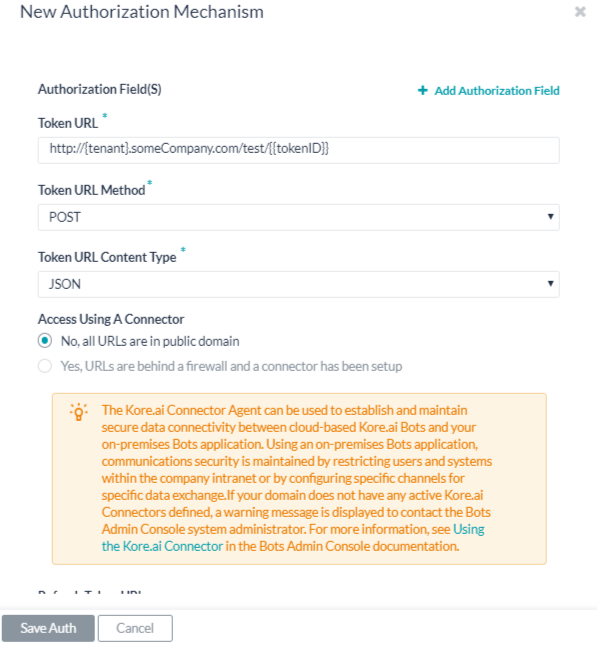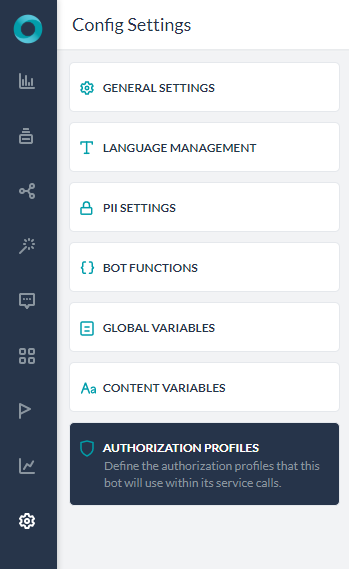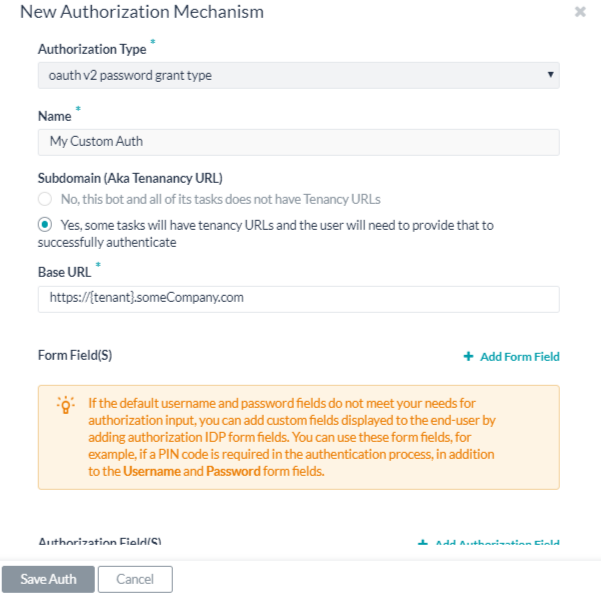To define Authorization for your bot, follow these steps:
- Open the bot for which you want to configure an Authorization profile.
- Select the Build tab from the top menu.
- From the left menus, click Configurations -> Authorization Profile

- Click Add. The New Authorization Mechanism dialog opens.
- In the Authorization Type drop-down list, select oAuth v2 password grant type.
- Define the fields to enable a customized authorization for your Bot.
Defining Tenancy
If required, in the Subdomain section, select Yes if the base URL for a web application or user interface the uses a tenant name in the URL. For example, kore is the tenant organization for a web service using tenants as www.kore.someCompany.com.
In the following example configuration, the tenancy URL contains the {tenant} organization placeholder.

Adding Authorization Fields
By default, authorization fields are configured as part of the header of the Bot request message. If your Bot request requires additional authorization fields or the expected authorization is not part of the header, for example, social security number or PIN, click Add in the Authorization Fields section and then define the fields as shown in the following illustration.
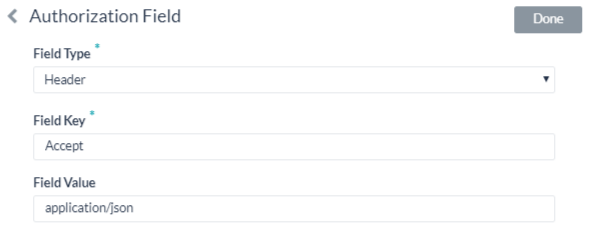
- In the Field Type field, you can select one of the following depending on where in the Bot request message and the type of authorization fields that are required.
- Header – The Bot expects the authorization fields as part of the header of the request.
- Payload – The Bot expects the authorization fields as part of the content of the body of the request.
- Query String – The Bot expects the authorization fields as a query in the body of the request.
- Path Param – The Bot expects the authorization fields as part of the URL path for the request.
- In the Field Key field, enter the name of the field for the selected Field Type.
- In the Field Value field, enter the value for the Field Key specified.
- Click Add. The new authorization field is added in the Authorization Fields section.
- To add additional authorization fields, click Add in the Authorizations Fields section.
Adding Form Fields
If the default username and password fields do not meet your needs for authorization input, you can add custom fields displayed to the end-user by adding authorization IDP form fields. You can use these form fields, for example, if PIN code is required in the authorization process.
To add fields on the authorization form, click Add in the IDP Form Fields section. The following illustration is an example of a definition to add a password field to the authorization dialog.
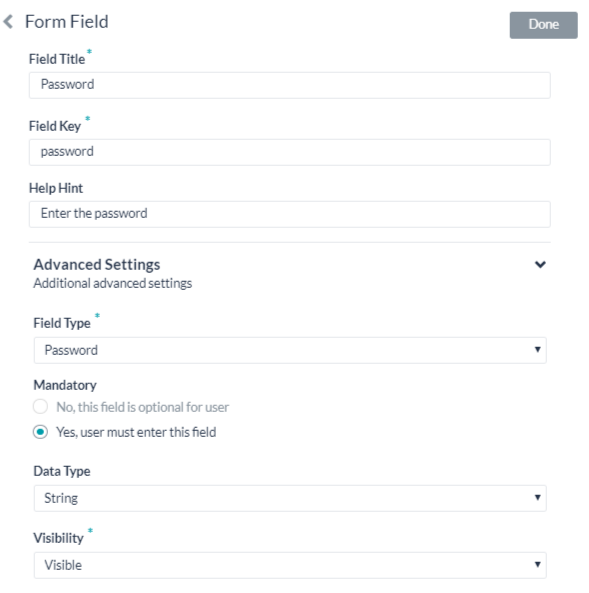
The following table describes the fields used to define an authorization IDP form field.
| FIELD NAME |
DESCRIPTION |
| Title of Field |
Specify the name of the field displayed to the end-user in the authorization dialog. |
| Field Key |
The value represents the end-user input value to the authorizing service. |
| Help Hint |
The help text displayed in the field to describe what should be entered into the field. |
| Field Type |
When Advanced Options is selected, specify the type of field displayed in the end-user interface to collect the user input assigned as the value for the Field Key, one of:
|
| Mandatory |
When Advanced Options is selected, select if the end-user must define this field to complete the authorization. |
| Data Type |
When Advanced Options is selected, specify the type of data expected as input from the end-user, for example, String. |
| Visibility |
When Advanced Options is selected, specify if the authorization field should be visible, hidden, or displayed as read-only. |
Defining the Token URL
In the Token URL field, optionally define a URL that can be used to test the authorization settings from Bot Builder before you deploy the Bot with the authorization mechanism. You can use dynamic fields, path parameter fields, query fields, and so forth, to define the test URL, for example,
http://{tenant}.someCompany.com/test/{{tokenId}}
In the Token URL Method field, select the HTTP request method type for the Token URL. One of PUT, POST, PATCH, DELETE, and GET.
In the Token URL Content Type field, select the content type expected from the Token URL. One of: JSON, RSS, XML, URL Encoded JSON, CSV, Text, Twitter Encoded JSON, Multipart/Form-data,Multipart/Related, or Oracle ADF.
Access using Connector
In the Access Using a Connector section, select Yes to enable access for Kore.ai Bots using the Kore.ai Connector agent. If your domain does not have any active Kore.ai Connectors defined, a warning message is displayed to contact the Bots Admin Console System Administrator. For more information, see Using the Kore.ai Connector in the Bots Admin Console documentation.
Click Save Auth to save the authorization settings and close the New Authorization Mechanism dialog.
Testing the Authorization
After you save the authorization, you can test your authorization definition when you click Test from the Authorization Profile page. When you click Test, the Test Authorization dialog is displayed and populated with the URL you specified in the Authorization Check URL section.
Click Test to begin the authorization test. When the validation of authorization is complete, the Test Authorization dialog is closed and the results of the validation, either success or failure, is displayed to the immediate right of the Test Authorization button.
If the authorization fails, the Auth Test Failed message is displayed along with the Headers and Response tabs as shown in the following illustration.
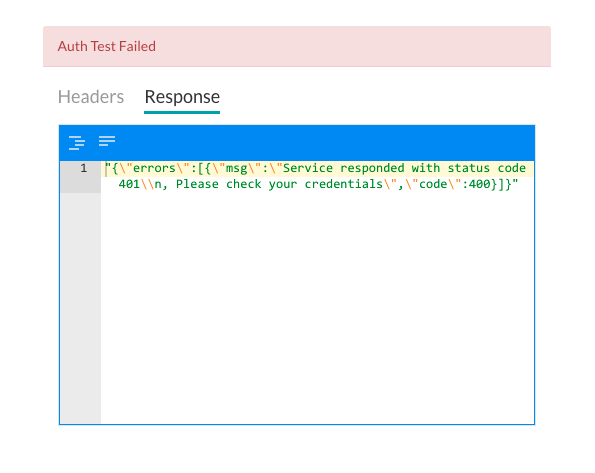

 以下のテーブルは認証IDPフォームフィルドの定義に使用するフィルドの説明です。
以下のテーブルは認証IDPフォームフィルドの定義に使用するフィルドの説明です。